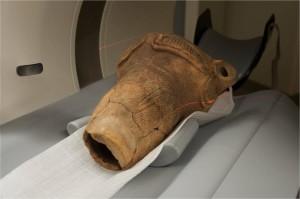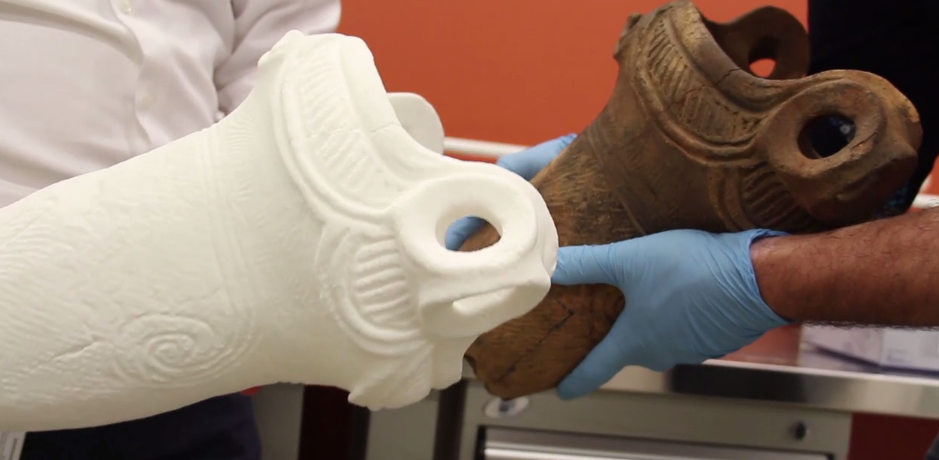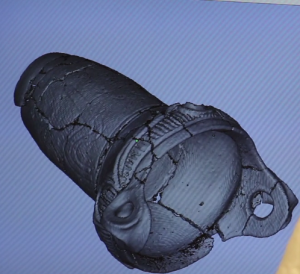 In the Neolithic era, Japan was home to a culture of people known as the Jōmon. A race of hunter-gatherers, the Jōmon are known for their distinctive pottery, which is, according to experts, the oldest pottery in Japan. The pottery, made with unrefined clay and decorated by pressing rope into the surface of the clay before firing, has been found in numerous archaeological sites across Japan. Radiologic dating has shown fragments of the pottery to date back as far as 12700 BCE, though many researchers theorize that it was made even earlier than that time.
In the Neolithic era, Japan was home to a culture of people known as the Jōmon. A race of hunter-gatherers, the Jōmon are known for their distinctive pottery, which is, according to experts, the oldest pottery in Japan. The pottery, made with unrefined clay and decorated by pressing rope into the surface of the clay before firing, has been found in numerous archaeological sites across Japan. Radiologic dating has shown fragments of the pottery to date back as far as 12700 BCE, though many researchers theorize that it was made even earlier than that time.
It’s amazing that anything that old survives today, and it’s even more amazing that some of it still remains whole. James Koyanagi, a retired architect in Burlington, Ontario, is the owner of a Jōmon vase that dates back to 4000 BCE. Such an object leaves researchers salivating, but due to its extreme age and fragility, close study of the vase hasn’t been possible without incurring damage. Until now, that is.
Mohawk College in Hamilton, Ontario is home to the sophisticated Additive Manufacturing Resource Centre (AMRC). Opened in 2014, it’s already established a reputation for being one of the best sources of 3D printing and additive manufacturing research and education in Ontario. Mohawk professors Reid Flock and Robert Gerritsen decided to take advantage of the facility to recreate Koyanagi’s vase in perfect detail.
 It wasn’t a simple project. To scan the vase, a high resolution CT scanner would be needed, so the professors reached out to Trillium Health Partners – Mississauga Hospital and Siemens Healthcare, who provided them with the medical-grade scanner they needed. A Siemens SOMATOM Definition Flash CT scanner was used to scan both the inside and outside of the vase, and a 3D CAD model was created. The file was then used to 3D print a copy of the vase in Nylon 12. The result was a perfect replica that can now be examined and studied without the fear of damage. It can also be used to digitally recreate the missing pieces of the vase, which can then be 3D printed.
It wasn’t a simple project. To scan the vase, a high resolution CT scanner would be needed, so the professors reached out to Trillium Health Partners – Mississauga Hospital and Siemens Healthcare, who provided them with the medical-grade scanner they needed. A Siemens SOMATOM Definition Flash CT scanner was used to scan both the inside and outside of the vase, and a 3D CAD model was created. The file was then used to 3D print a copy of the vase in Nylon 12. The result was a perfect replica that can now be examined and studied without the fear of damage. It can also be used to digitally recreate the missing pieces of the vase, which can then be 3D printed.
“What we have experienced with the help of Siemens Canada and the AMRC at Mohawk are two firsts,” said Flock. “To our knowledge, no one has CT scanned a Neolithic Jōmon piece in its entirety and had it 3D sintered. As you can imagine, the applications with this are far reaching. Conservation and restoration efforts, study collections, and artistic possibilities within the ceramics field will greatly benefit from our research.”
 The AMRC, which already had the distinction of being the only additive manufacturing resource center in Ontario with the capability to print metal, is now one of the first organizations in Canada to build a CAD file using medical data to recreate an archaeological piece. It’s also among the first colleges, and the only one in Ontario, to use a combination of 3D printing and 3D scanning to advance archaeological conservation and preservation.
The AMRC, which already had the distinction of being the only additive manufacturing resource center in Ontario with the capability to print metal, is now one of the first organizations in Canada to build a CAD file using medical data to recreate an archaeological piece. It’s also among the first colleges, and the only one in Ontario, to use a combination of 3D printing and 3D scanning to advance archaeological conservation and preservation.
“It’s very exciting to see advanced healthcare and advanced manufacturing technology being combined for a new and unique application such as archaeological study,” said Jim Graziadei, Managing Director, Siemens Healthcare Canada. “Siemens is amazed at what was accomplished by our partners at Trillium Health and Mohawk College using our CT scanner and we are honoured to have been a part of it.”
The project involved a large team of people that included both students and professors from Mohawk College, along with healthcare professionals from Sunnybrook Hospital. Tremendous advancements in archaeological research have been made recently thanks to 3D scanning and printing, and the Jōmon project is an example of how archaeology is becoming a much more interdisciplinary field as the technology has advanced.
“This is an opportunity to bring Health Care, the Arts and Technology together through the use of Additive Manufacturing,” said Tony Thomas, Dean of Engineering Technology at Mohawk College. “The entire process, from scanning to the printing, has produced an impressive final product that we can use for further conservation efforts.”
Discuss this story in the 3D Printed Japanese Vase forum thread on 3DPB.com.
Subscribe to Our Email Newsletter
Stay up-to-date on all the latest news from the 3D printing industry and receive information and offers from third party vendors.
You May Also Like
3D Printing News Briefs, April 27, 2024: Research, Digital Dentistry, Cycling, & More
We’re starting today’s 3D Printing News Briefs with some research into 3D printed luminescent quantum-dot polymer architectures and free-form laser beam shaping, and then on to an open source 4-axis...
HP & INDO-MIM Collaborate to Boost Metal 3D Printing in India
HP Inc. and INDO-MIM, a US- and India-based supplier of metal injection molding (MIM) powders and contract manufacturer, have announced that the two companies will collaborate to accelerate additive manufacturing...
3D Printing News Briefs, February 17, 2024: Shot Blasting, Service Bureaus, & More
In today’s 3D Printing News Briefs, we’re starting out with post-processing, as SKZ Würzburg is using a shot blast system from AM Solutions for its research. Moving on to business,...
3D Printing News Unpeeled: Not That Kind of Organ 3D Printing
GKN Aerospace will create a 150 jobs in Trollhattan Sweden with an investment of $60 million part of which comes from the Swedish Energy Agency’s Industriklivet initiative. The investment will...






























